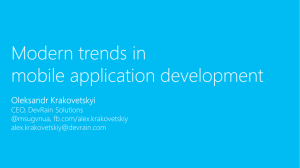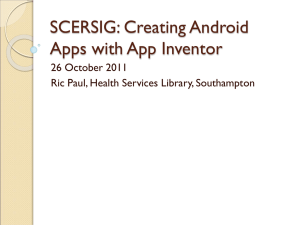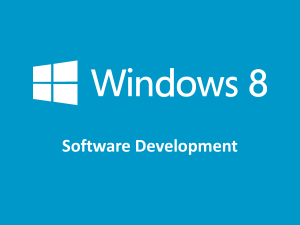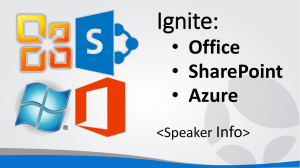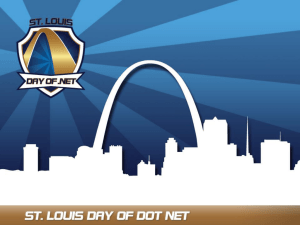slides
advertisement
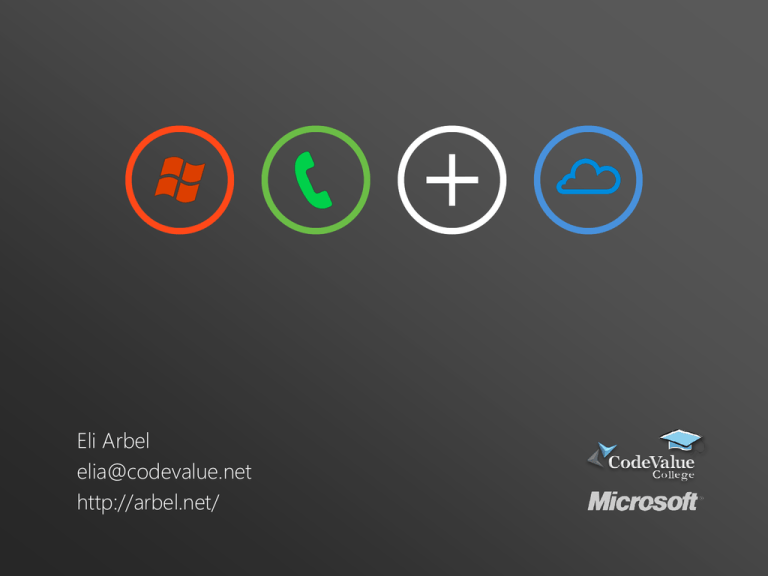
Eli Arbel
elia@codevalue.net
http://arbel.net/
About CodeValue
CodeValue is the home of software experts
o CodeValue builds software tools, foundations
and products for the software industry
o CodeValue offers mentoring, consulting and
project development services
o We love technologies, we believe in excellency
http://codevalue.net/
agenda
o
o
o
o
o
introduction
silverlight development
phone development
using azure in your app
the marketplace
introduction
features metro
o new platform
o
o
cloud
based on familiar technologies and tools
multiple hardware vendors
o
o
tools
consistent baseline (cpu, resolution, etc.)
your chance to enter a brand new market!
introduction
features
metro
tools
cloud
METRO IS WINDOWS PHONE’S DESIGN
LANGUAGE. IT’S MODERN AND CLEAN. IT’S
ABOUT TYPOGRAPHY AND CONTENT.
metro
metro
metro
principals
clean, light, open, fast
celebrate typography
alive in motion
content, not chrome
metro
app hubs
introduction
features
metro
tools
cloud
Phone Emulator
Samples
Documentation
Guides
Community
Packaging and Verification Tools
introduction
features
metro
Notifications
Location
tools
cloud
App Deployment
Identity
Feeds
Social
Maps
SILVERLIGHT
silverlight
introduction
o a subset of the .net framework and WPF
o first introduced as a browser plug-in
o
o
.net runtime on multiple platforms (mac, windows)
currently targeted for:
o
o
o
o
device apps (currently windows phones)
client apps (emphasis on enterprise)
rich media apps (such as streaming video)
reuse code for desktop, web and phone apps!
silverlight
principals
o code + xaml
o controls
o layout
o data binding
o graphics
code + xaml
o
o
xaml is basically a declarative language for object
instantiation
xaml is great for UI development. it’s:
o
o
o
o
o
standard XML
hierarchical
extensible
declarative
we can do most things both in xaml and in code,
but you’ll quickly find that xaml is much more
convenient for some tasks
code + xaml
comparison
XAML
<Grid x:Name="ContentPanel"
Margin="12,0,12,0">
<TextBlock Text="Hello, Windows Phone 7!"
Margin="6"
HorizontalAlignment="Center"
VerticalAlignment="Center" />
</Grid>
C#
var tb = new TextBlock();
tb.Text = "Hello, Windows Phone 7!";
tb.HorizontalAlignment = HorizontalAlignment.Left;
tb.VerticalAlignment = VerticalAlignment.Top;
tb.Margin = new Thickness(6);
ContentPanel.Children.Add(tb);
code + xaml
the visual tree
o controls contain other controls, and some
controls are built using other controls
o this creates a hierarchical relationship between
the controls which we call the visual tree
o when you write xaml, the structure of the
visual tree is very clear
demo
hello, xaml
controls
controls
anatomy
o inherits from FrameworkElement
o two main types:
o
o
o
o
custom control – a reusable, templatable control
(e.g. a button)
user control – a way to modularize your
application (e.g. employee view)
uses dependency properties and routed
events
responds to input (touch, keyboard)
controls
dependency properties
o extend CLR properties with:
o
o
o
o
o
data binding
change notification
animation
validation
control-tree inheritance
controls
routed events
o extend CLR events
o can travel along the visual tree:
o
bubbling or tunneling
controls
routed events
Root
Element 1
Element1.
1
Element
1.2
Element 2
Element
2.1
Element
2.2
PreviewMouseDown on Root
PreviewMouseDown on Element 1
PreviewMouseDown on Element 1.2
MouseDown (bubble) on Element 1.2
MouseDown (bubble) on Element 1
MouseDown (bubble) on Root
layout
basic properties
Container
Vertical Alignment
Margin
Horizontal
Alignment
Padding
{Min,
Max}
Height
Element
Render Transform
{Min, Max} Width
layout
panels
o Grid
o StackPanel
o WrapPanel (*)
o Canvas
* can be found in the silverlight toolkit
demo
layout with panels
controls
styles
o defines a set of dependency properties and
values
o similar to CSS in HTML
o provides a great way to control the looks of
your app from a central location
controls
templates
o completely customize appearance of controls
without having to write any code or inherit
from the control
o all controls have default styles and templates
o template editing is easy with Expression Blend
demo
template editing in blend
data binding
o
flow data from a source to a target
o
o
o
o
source: any CLR object
target: Dependency Property only
modes: one way, two way
supports change notifications
o
o
changes to a source object automatically sent to
the UI
both property and collection changes are
supported
data binding
data templates
o provide a visual representation of an object
o
o
o
o
the default behavior if no template is specified is
to display the Object.ToString() result
use bindings to display data
respond to changes using triggers
can only be written in xaml
data binding
collections
o use ItemsControl whenever you need to bind
to a collection
o provide an ItemTemplate to change the visuals
of each item
o controls that inherit from ItemsControl:
o
ListBox, ContextMenu, MenuItem, Panorama
demo
data binding
data binding
the mvvm pattern
o
o
o
o
o
designed specifically with
WPF/Silverlight in mind
relies on bindings to retrieve
and set data from and to
the view model
uses commands to perform
operations on the view
model
relies on notifications to
communicate between the
layers
creates a data-driven UI
Model
View
Model
View
business logic and
data
presentation logic
and state
UI (and possibly
some UI logic)
graphics
images
o store images as resources or as content
o
o
o
content is recommended
use the Image control to show them
use WritableBitmap to create images in
runtime
o
you can also use it to capture your screens
graphics
vectors
o controls inheriting from Shape can be used to
create 2D shapes
o
o
o
Rectangle, Ellipse, Line, Polyline, Polygon, Path
Path is the most versatile, accepting a
Geometry object which can represent any
shape
it is easiest to create shapes using Expression
Blend
graphics
transforms
o FrameworkElement has a RenderTransform
property which can be assigned to:
o
o
o
o
o
o
TranslateTransform (move)
ScaleTransform
RotateTransform
SkewTransform
CompositeTransform (combine any of the above)
additionally, the Projection property allows
creating 3D-like effects
graphics
animations
o
animate dependency property using a Timeline
that fits the property type:
o
o
o
o
DoubleAnimation, ColorAnimation, PointAnimation
use Storyboard to group a few animations
together
use an easing function to make the animation
look more “real” (e.g. to add elasticity)
it’s easiest to create storyboards in xaml and in
Expression Blend
demo
animations
resources
o
silverlight toolkit
http://silverlight.codeplex.com/
o
prism
http://prism.codeplex.com/
o
project rosetta (tutorials)
http://visitmix.com/labs/rosetta
o
Introducing Expression Blend 4
http://expression.microsoft.com/en-us/ff624124
break
WINDOWS PHONE
windows phone
o
o
o
application structure
phone-specific controls
sensors and services
application structure
files
o App.xaml: application entry point. contains
global resources, services, events (startup,
shutdown, etc.) and instantiates
PhoneApplicationFrame
o WMAppManifest.xml: contains application
deployment information: capabilities, tasks,
icon.
o MainPage.xaml: a PhoneApplicationPage that
contains the main view of the application.
application structure
default control tree
o
PhoneApplicationFrame
o
PhoneApplicationPage
o
o
Grid named “LayoutRoot”
StackPanel named “TitlePanel”
o
o
o
TextBlock named “ApplicationTitle”
TextBlock named “PageTitle”
Grid named “ContentPanel”
o
<your content goes here>
you can clear the entire page content
and write your own, but for most apps
it is recommended to stay within the
‘metro’ guidelines
application structure
navigation
o
just like a web browser, each page in windows
phone can be navigated to using the
NavigationService by passing a URI
o
o
o
the PhoneApplicationFrame can only display a single
page at a time!
the hardware back button can be used to go
back to the previous page on the stack
you can pass data to the page using URI query or
by placing it in a globally known location (such as
the App class)
application structure
windows phone can only run one application at a time.
tombstoning
o
o
so, each time you switch to another application, the
current one gets terminated – i.e. tombstoned
your app will get tombstoned if:
o
o
o
o
o
you click the start button
you get a call while the app is running
the phone gets locked
the app uses a launcher or a chooser (e.g. use the camera)
you can use the app’s Activated and Deactivated events
to handle tombstoning
demo
tombstoning
application structure
application bar
o preferred menu system for
your apps
o up to 4 buttons,
monochrome 62x62 bitmaps
o
o
o
add a button from Blend to
get some default bitmaps
get more from
http://thenounproject.com
add up to 5 menu items
demo
application bar
phone controls
o
most of silverlight’s controls have been
adjusted to windows phone, supporting touch
and templated to the phone’s theme
o
while some controls such as ComboBox and
ToolTip exist on the phone, their use is
discouraged
phone controls
panorama and pivot
o
o
panoramic applications
offer a unique way to
view controls, data, and
services by using a long
horizontal canvas that
extends beyond the
confines of the screen.
pivot can be used for
filtering large datasets,
viewing multiple data
sets, or switching
application views.
demo
panorama & pivot
sensors
accelerometer
o
measures acceleration forces such as gravity or
the forces caused by moving the sensor
o
o
can tell the direction of the earth relative to the phone
use the Accelerometer class to access the sensor
o
o
this sensor reports a constant value in the emulator, so
it is recommended that you mock its values for testing
possible uses: responding to phone movements
in games, bubble levels, etc.
demo
accelerometer
sensors
geo-location
o obtain the current location of the phone using
the GeoCoordinateWatcher class
o you can get the latitude, longitude, altitude
and current speed of the device
o this sensor is not available in the emulator. use
the GpsEmulator project, available at app hub
o use the Bing maps control to display a map of
the current location
sensors
camera
o obtain photos from the camera using the
CameraCaptureTask chooser
o get a Stream from the chooser and create a
BitmapImage from it
o the emulator will provide a simple black-andwhite image to capture
demo
camera
services
push notifications
o
o
allows applications to receive updates in the
background (app doesn’t need to be running!)
three types of notifications:
o
o
o
o
toast – when app is inactive
tile (background, title, count)
raw – directly to the app
you need to create a compatible web service
what’s coming
in version 7.5 (aka “mango”)
o
o
o
o
o
o
o
o
internet explorer 9
SQL CE: in-memory local SQL database
multi-tasking and live agents
silverlight 4
raw camera feed access
tcp/ip sockets
better developer tools
beta sdk shipping this month
resources
o
Programming Windows Phone 7 by Charles
Petzold (free ebook)
http://www.charlespetzold.com/phone/
o
Windows Phone 7 Developer Guide
http://msdn.microsoft.com/en-us/library/gg490765.aspx
o
quickstarts
http://create.msdn.com/en-us/education/quickstarts
o
the noun project (icons for your app)
http://thenounproject.com/
break
USING AZURE IN YOUR APP
windows azure
in a nutshell
Windows Azure and SQL Azure help developers
build, host and scale applications through
Microsoft datacenters. it allows you to:
o focus on development not infrastructure
o respond faster to customer needs
o use your existing .net skills in the cloud
windows azure
features
o compute (virtual server)
o database
o caching
o content delivery network
o service bus
o access control
o and more!
phone+azure
o
use azure web roles for hosting web services
o
o
store data on azure tables
o
o
e.g. push notifications
e.g. user registration, personalization
use the content delivery network (CDN) to
host your media (images, videos, etc.)
phone+azure
toolkit
o visual studio templates for an azure-backed
windows phone app
o provides:
o
o
o
o
user registration and authentication service
access azure tables using OData
serve push notifications
administration website
demo
toolkit app
resources
o
Windows Azure Toolkit for Windows Phone 7
http://watoolkitwp7.codeplex.com/
o
short introduction to azure
http://msdn.microsoft.com/en-us/magazine/ee336122.aspx
THE MARKETPLACE
marketplace
advantages
o integrated into the phone
o
o
o
o
use the zune software to browse on the PC
free or paid apps with a trial option
downloads, updates and payments are
managed for you
free registration for students using
DreamSpark
marketplace
steps
develop
& debug
submit
& validate
windows phone
application
deployment service
certify
& sign
marketplace
marketplace
best practices
o make it appealing (use metro!)
o make it stable and reliable
o make it original and useful
o make it easy to use
o read the certification requirements carefully
o
test your app as suggested to avoid common
certification pitfalls
marketplace
in israel
o currently not supported directly in App Hub
o use a third-party broker: yalla apps
o as a student, you get 100 credits which you
can use to:
o
o
upload apps
unlock devices for development
resources
o
certification requirements
http://msdn.microsoft.com/en-us/library/hh184843(v=VS.92).aspx
o
dreamspark
https://www.dreamspark.com/
o
yalla apps
http://www.yallaapps.com/
o
best practices for application marketing
http://create.msdn.com/enUS/home/about/app_submission_walkthrough_application_marketing
thank you!

